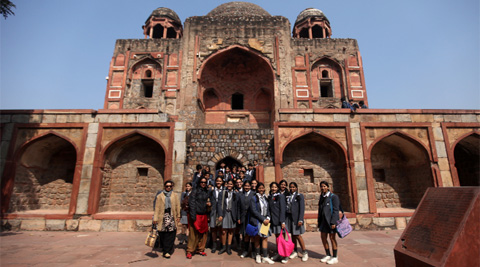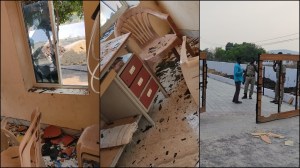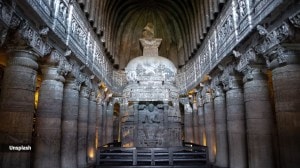- India
- International
Slice of capital’s less-known but rich heritage
Quest organised a heritage walk at RAHIM KHAN-I-KHANA’S TOMB for the students of St Mark’s Sr Sec Public School, Meera Bagh
 Students of St Mark’s Sr Sec Public School at Rahim Khan-i-Khana’s tomb
Students of St Mark’s Sr Sec Public School at Rahim Khan-i-Khana’s tomb
A schools’ initiative from The Indian express.
Quest organised a heritage walk at RAHIM KHAN-I-KHANA’S TOMB for the students of St Mark’s Sr Sec Public School, Meera Bagh
Our school took us for a heritage walk to Khan-i-Khana’s Tomb. The tomb is named after Abdul Rahim Khan-i-Khana, who was one of the Navratans in Akbar’s court. He served both Akbar and Jahangir. Rahim Khan constructed the tomb on his wife’s death in 1598 and was later buried in it in 1627. Designed in a similar fashion to Humayun’s Tomb, it is made of red sandstone, buff sandstone and marble. Today, the monument is protected by the ASI. We were told that the stones were stripped off later from the monument to build Safdarjung Tomb in 1753. The heritage walk taught us a lot about Mughal architecture.
Twisha Yadav, X-A
Rahim’s Tomb is also popularly known as Khan-e-Khana Maqbara, as it was built as a tribute to Rahim’s wife when she passed away. Mirza Abdul Rahim Khan, also called Khan-e-Khana, was the son of Emperor Akbar’s instructor, Bairam Khan. He devoted his life working for Emperor Akbar and Jahangir. He was a composer during Akbar’s reign and was also among his nine gems. Rahim’s tomb is an arch-shaped structure. It is made up of red stone, buff stone and marble. It is decorated using the structure of an inverted lotus. The stones were brought from Aravali hills while the white marble was brought from Agra to build this tomb. It is built a few metres above the ground to show the prosperity of Rahim. It includes different architectural styles.
Prisha Handa, X-C
The tomb is one of the rarest monuments in Delhi situated near the Humayun’s Tomb complex in Central Delhi. Rahim was one of Akbar’s nine gems, who wrote couplets based on Lord Krishna as Akbar’s wife, Jodha, worshipped Lord Krishna. Rahim built this tomb to bury his wife and later his own body was buried there. During the Safdarjung reign, the kings took out stones from this tomb to build the Safdarjung Tomb. We were also told about the peculiarities of Mughal architecture and many other interesting facts about not only this monument, but many other famous ones too. In a nutshell, it was a very interesting and a knowledgeable tour.
Sanjana Choudhary, X-B
Abdul Rahim Khan-i-Khana was the son of Bairam Khan, Akbar’s guardian and mentor. After the death of Bairam Khan, his second wife Salima Begum Khan married Akbar, which made Rahim his stepson. He was given the title of Mirza Khan by Akbar. Later, he became one of the prominent ministers in Akbar’s court. He was a humble and kindhearted man. Inspite of being a Muslim, he also wrote many couplets on Lord Krishna. Rahim Khan built this tomb for his wife in 1598 and, later, his own body was placed here after his death in the year 1627. The tomb is a beautiful place. The main motive of this short trip was to take us through a small walk though Delhi’s history. It gave me a glimpse of things that happened in the past.
Isha Joshi, X-A

Mirza Abdul Rahim Khan was the stepson of Mughal Emperor Akbar. Biologically, he was the son of Akbar’s nine gems, Bairam Khan. Abdul Rahim Khan was proficient in many languages. He wrote couplets in Hindi, which were dedicated to Lord Krishna. He was also the Prime Minister during the rule of Akbar. He served Akbar as well as Jahangir. Initially, Rahim made this tomb for his wife who died in 14th Century, but later on, after his death in the15th Century, he was also buried in this tomb. The tomb is a two-storied building. The structure of the tomb is inspired by that of Humayun’s Tomb. This tomb is made up of three type of stones — red sandstone, white sandstone and quartzite stone.
Pooja Chauhan, X-C
This tomb was named after Abdul Rahim Khan and is situated at Nizamuddin in Central Delhi. I was really mesmerised by its architecture. The tomb was made with red sandstone, which was brought from Agra and marble. This tomb was made by Rahim in the memory of his wife after her death in 1598 and later on, he was himself buried after his death in 1627. The cenotaph of Rahim is placed in the central chamber of the tomb. Our guide told us a variety of things. He told us that this tomb is the part of the same complex of Humayun’s Tomb and also that material was stripped off the tomb for the construction of Safdarjung Tomb. The tomb is a double-storied structure. I was a little sad to see the sorry state of the walls of the tomb with vulgar signs and comments scribbled on them, which marred its beauty, but, on the contrary, the whole experience was exciting, interesting, stimilating and enriching.
n Gursimran kaur, X-D
The tomb was built by Rahim Khan for his wife. It was built in 1598. Rahim Khan was one of the Navratans in Akbar’s court. Today, the monument is looked after by the Archeological Survey of India. The tomb is located in Central Delhi. The significance of the tomb was explained to all the students by a professional guide. It was great fun to be at the tomb and to know about Mughal emperors and their taste in art, architecture and love for their beloved ones. It was a wonderful feeling and experience to know more about the rich history of India.
Kriti Sachdeva, X-A
The trip was an awesome experience. The tomb is of Abdul Rahim Khan-i-Khana. The trip was intended to make students experience the vastness of the Indian architecture in the 16-17 century. The tomb was chosen so that the students could experience the richness of Mughal architecture. The architecture reflects mainly the Persian style that came to India with the Mughals and the Rajput style that existed in India. The Persian style is more dominant in these architectural marvels, which give these buildings the arch-shaped entrance and dome- shaped roofs. The information and details provided by our teachers and guide left us gaping and gave us a moment to take pride in our history and culture that was native to us and that we inherited from the Mughals.
Aman Gupta, X-A
The heritage walk was organised to give the students an insight into the art and architecture that existed centuries ago. The trip helped students learn about Mughal history and culture. Along with it, they also came to know about one of the greatest poets of ancient times, who was also one of the nine gems of Akbar. The students were accompanied by a guide who showed the monument to the students and explained to them the minute and intricate details related to its architecture. The beautiful arches, domes and the exceptional use of red sandstone for the carvings on the wall left the students awestruck. They learnt about different styles of art like Pietra-dura.
n Ishan Arora, X-A
It is one of the three UNESCO World Heritage sites located in Delhi. Archaeological Survey of India is responsible for archaeological studies and the preservation of this cultural monument. This tomb is situated in Central Delhi, near Humayun’s Tomb. It was built by Khanzada Mirza Khan Abdul Rahim Khan-e-Khana for his wife in 1598, but later served as a site for his own burial. The beautiful monument is made of marble and sandstone. Some of this marble and sandstone were stripped off and used in the construction of Safdarjung’s Tomb in New Delhi.
Our guide explained to us the various architectural styles like arches, gumbads and niches, which are seen in the Mughal monuments.
Saumya Verhwani, X-E
We were briefed by the guide who was there to tell us about the tomb and Indian heritage in general. First of all, we were told that Rahim was one of the nine gems in Akbar’s court and was the son of Bairam Khan, Akbar’s guardian.
We also came to know some very interesting facts such as the material used in construction, the features which distinguishes it as a Mughal architecture etc. Apart from this, we were told about the working of UNESCO and the Archaeological Survey of India with regard to the preservation of monuments. We learnt how important it is to maintain ethical values even during restoration works.
Suasha Girdhar, X-D
Apr 18: Latest News
- 01
- 02
- 03
- 04
- 05






































